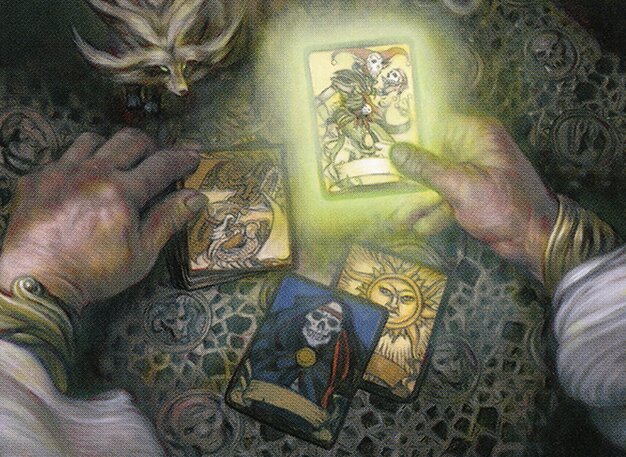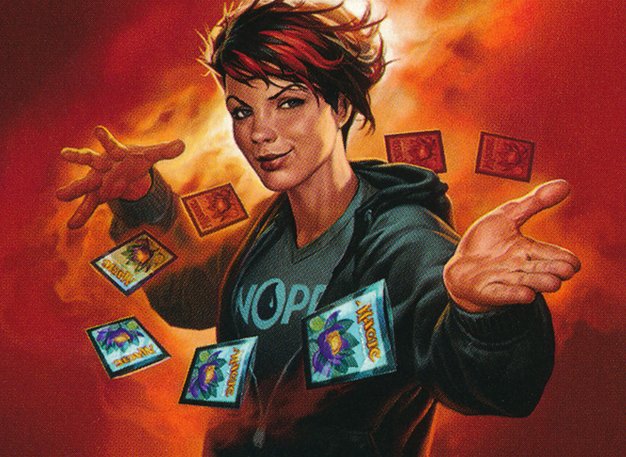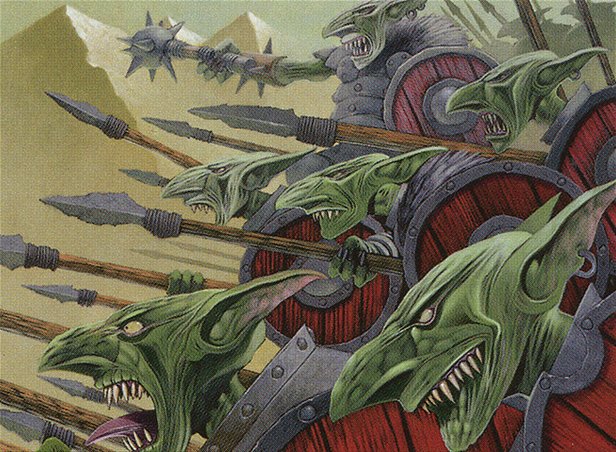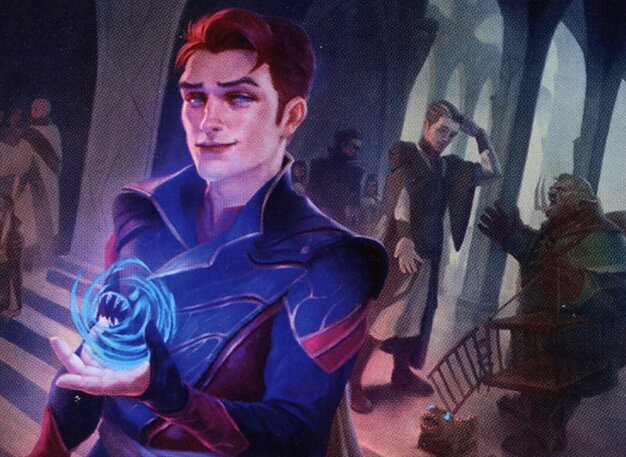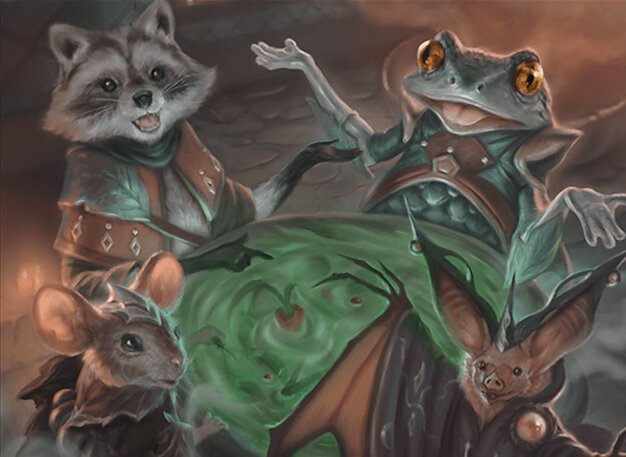Brew like a Game Designer - Your Decks are Keeping Secrets
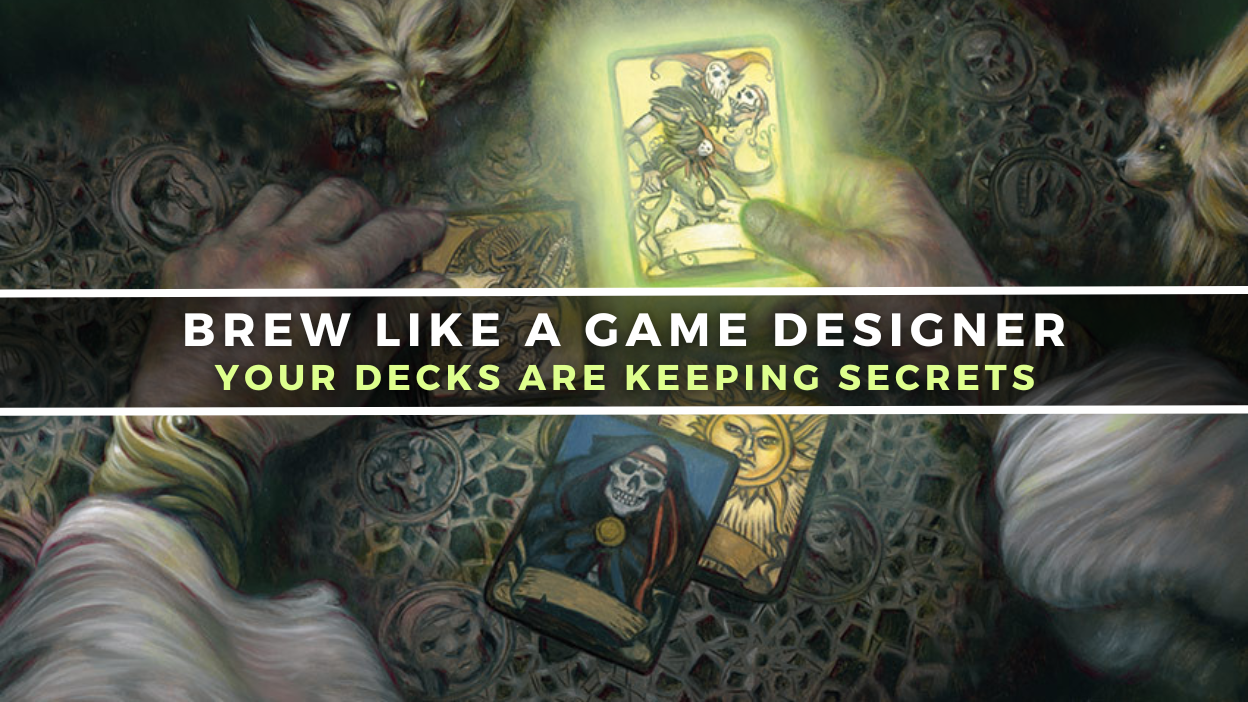
What Are Your Cards Not Telling You?
Cheers! My name is Kieran Sheldon (they/he), and I'm the reason Abyssal Persecutor
In this series, we'll explore the aspects of deckbuilding that you'll never find in a mana curve graph or in the expansive archives of Commander's Spellbook. We'll be reading deep between the lines of rules text, reminder text, and flavor text, because in this mystical land, reading the card does not explain the card.
In this article, I'm going to lay out my basic philosophy for deckbuilding like a game designer. After that, we're going to take a deep dive on one specific card
Ready? Let's go!
(The Deck of Many Things | Art by Volkan Bága)
Does This Sound Familiar?
Picture the situation: you brew a new Commander deck, perhaps inspired by a recently printed legendary creature or an obscure mechanic from Magic's yesteryear. It took hours of combing through EDHREC and Scryfall, but you've concocted the perfect list. It's got innovative card choices, a precise balance of value and interaction, and an elegant, intentional mana curve. After selling a kidney, you place an order for singles. Game night finally arrives.
And the deck works great! You've been reading Commander's Herald, after all, so you know how to build a tight 99. Your ramp ramps, you draw half your deck, and you execute a clean, merciful victory. Then you do it again.
Except... after that first game night, you lose interest. You reach for your new deck less and less. Within a few months, you declare the deck legally deceased and start scavenging it for parts. Maybe you need that Farewell
(Healing Salve | Art by Greg Hildebrandt & Tim Hildebrandt)
A Cure for UDS
Unfortunately, Unfun Deck Syndrome (UDS) is all too common among modern Commander players, and I'm not talking about decks that are unfun to play against (Tergrid
The tragic spread of UDS makes sense. The majority of Commander content centers around the question, "How do I build a powerful, effective Commander deck?" This is a great question... and I won't be answering it in this series. Plenty of community content already focuses on power and synergy, and that's fantastic! However, the volume of content about building a strong deck may overshadow another, equally important issue: building a fun deck.
Behold! A series centered on the intricacies of experience design with the goal of making your Commander decks as fun to play as possible. Each episode of Brew like a Game Designer will detail aspects of game design, from tutorial design to game theory, and examine how you can use those ideas to make your decks more fun to play with (and against).
The Core Theory
Here's the secret: if you build your own Commander decks, you're already a game designer. Every time you select a new card for a deck, you're taking an active role in designing the play experience of your next Commander game. That's because the specific cards in your deck inherently encourage you and your opponents to act in certain ways, both fun and unfun.
For instance, when you draw Blasphemous Act
In this way, not only does your in-game behavior affect what cards you choose to play, but the cards you put in your deck directly determine your in-game choices and the choices of your opponents. These incentives are often hidden, but they affect you whether you're conscious of them or not, so it's a good idea to think deeply about what sort of play patterns your decks are encouraging you to perform. Why not learn how to craft the best possible game for yourself to play?
We'll explore this idea more in a bit, but first let's lay some groundwork.
My Paltry Credentials
My name is Kieran. I use they/them or he/him pronouns, and I've been playing Magic since Zendikar (original flavor). I'm a registered Judge (or, at least, I was before Judge Academy shut down), and I've taught dozens of people to play our favorite game. I love toolbox decks with a dash of group hug, my favorite card is Sunforger
I'm also a lifelong storyteller with a degree in game design. I've worked professionally as a video game writer and as a Dungeon Master. I discovered my love of game design by reading old Making Magic and Savor the Flavor articles on Magic's website, and I'm honored to bear the writer's heavy pen for a new era of players.
With that out of the way, let's discuss the Loxodon in the room:
(Spike, Tournament Grinder | Art by Zoltan Boros)
Trying to Win
Critically, in our pursuit of fun, we're still going to build decks that can win games. Winning is fun! Losing a close game is fun! We're not going to abandon the core principles of effective deckbuilding in order to pursue our goals.
Also, I'm not encouraging you to pull any punches when you're actually playing your decks. Whether designing a game or building a deck, it's good to assume that your player (in this case, yourself) will try to win the game at any cost, even if that makes the game less fun. That's just how people are. Because of this, it's a game designer's responsibility to ensure that the best strategy in a game is also the most fun strategy.
Therefore, when building a deck, you should include cards that are fun to win with and avoid cards that make the game less fun when they're played to their fullest. For example:
Fun: "I put Disrupt Decorum
Not fun: "This game has already lasted two hours, but I drew my Farewell
(That's right! Farewell
In short, you don't need to give up on winning in the name of playing goofy, fun cards. Rather, I encourage you to play goofy, fun cards so that, during a game, you can try to win as hard as possible without inadvertently creating an unfun experience.
Notably, for some players, optimizing for efficiency and optimizing for fun may look very similar. Some people have fun by challenging themselves to build the best deck they can and play it as optimally as possible. And that's great! Everyone's idea of fun is different, and finding your own favorite way to play Magic is one of the game's inherent joys. However, I believe even the spikiest players can benefit from considering what sort of play experience their decks create for themselves.
Principles of Fun Commander Games
As mentioned, every person has a different definition of fun, but I believe that a few universal factors tend to generally contribute to a more fun Commander game:
- Fun Commander games are relatively balanced. Even if some decks and pilots are better than others, everyone should have a reasonable chance of winning.
- Fun Commander games are interactive. It's usually more fun to trade threats and answers than for each player to pursue a solitaire combo until someone wins. Social interaction is also generally fun; many of us choose this free-for-all multiplayer format because we enjoy politics, deals, and banter.
- Fun Commander games are dramatic. Whether several players claw simultaneously for the win or three underdogs team up to face an archenemy, games are most exciting when the outcome is constantly uncertain and players' choices cause significant swings in the game state.
- Finally, fun Commander games minimize unnecessary complexity. Magic is a wonderfully complicated game, but sometimes tracking all the counters from Cathars' Crusadegets a bit time-consuming.
Because we'll be building to optimize fun rather than to optimize power, we'll need to evaluate cards in a different light than usual. Sure, it's still important to consider foundational deckbuilding ideas like mana curve, ramp and card draw, and win conditions. However, over the course of this series, we'll also be considering more esoteric perspectives on card evaluation, like political impact, affordances, and cognitive load. Confused? Great! That's what I'm here for.
Card Spotlight: Curse of Opulence
Let's look at an example. It's time to talk about Curse of Opulence
If you've been playing Commander for a while, you've probably played with or against this card at least once. It's one of EDHREC's top 100 red cards, played in nearly 80,000 decks. It's also an excellent example of the difference between evaluating a card's mechanics and evaluating the play experience that a card encourages.
By examining Curse of Opulence
- It's ramp that can come online early.
- It's an enchantment, an Aura, and a Curse.
- It works best in a deck full of creatures that want to attack.
- It produces artifact tokens.
- It gives resources to your opponents.
All these mechanical aspects are important to consider when deciding whether Curse of Opulence
So, let's look at Curse of Opulence
(Fervor | Art by Wayne England)
Curse of Opulence Incentivizes Aggression
By explicitly rewarding players for attacking, Curse of Opulence
Crucially, this incentive applies not only to your opponents but also to yourself. If you cast Curse of Opulence
As a whole, this incentive means that Curse of Opulence
(Sly Instigator | Art by Justine Cruz)
Curse of Opulence Rewards Opponents for Attacking Elsewhere
Strangely, for a card that encourages aggressive gameplay, Curse of Opulence
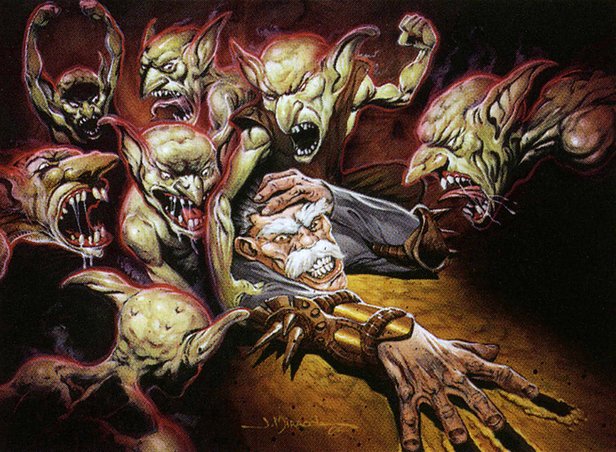
(Dogpile | Art by Jeff Miracola)
Curse of Opulence Encourages Ganging Up
Here's where things start to get interesting. Because Curse
Curse
(Communal Brewing | Art by Andreia Urgai)
Curse of Opulence Smooths Opponents' Games
Curse of Opulence gives Gold tokens to your opponents, which helps them cast their spells. I'd contend that this is often a fun thing! We've all played a Commander game where one player fails to draw enough lands, so they sit sadly doing almost nothing for 90 minutes. A little dash of group hug can fix that problem, providing opponents with the boost they need to get their game plan rolling.
Does this make it less likely that we'll win the game? Maybe, but I'd much rather lose a balanced game where everyone's deck "does its thing" than win a game by steamrolling mana-screwed opponents. Curse of Opulence hits a nice middle ground by smoothing opponents' games while also contributing to your victory by ramping you and encouraging your foes to attack each other.
Note that Curse isn't a perfect balancing solution, because it tends to reward players who are already ahead enough to make profitable attacks. If an opponent's so mana-screwed that they can't cast their creatures, it won't help that player much.
Additionally, in highly competitive pods where one or two mana can single-handedly make the difference between victory and defeat, Curse of Opulence might feel less fun and not make the cut.
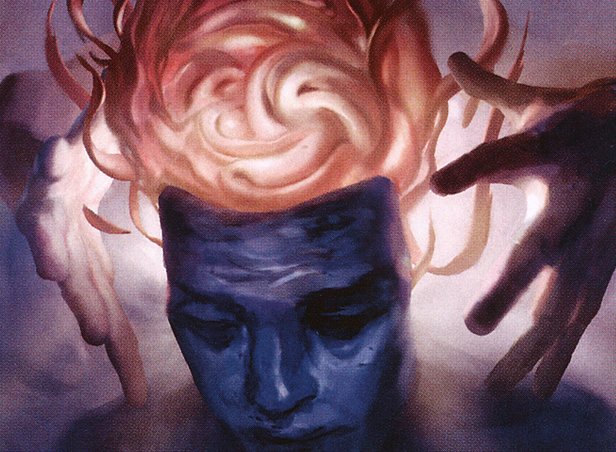
(Minds Aglow | Art by Yeong-Hao Han)
Curse of Opulence Demands Brain Power
By running Curse of Opulence in a deck, you're committing to thinking a little harder than usual. That's because Curse triggers off of opponents' actions, not just your own. If you've Cursed someone, you'll need to pay more attention during your opponents' combat phases. You'll maybe even need to gently remind your opponents of the potential riches that await if they attack someone other than you.
In addition, because Curse produces Gold tokens, not Treasure tokens, it necessitates additional tracking in decks that also make Treasures. You can't sacrifice Curse's tokens to Professional Face-Breaker, for instance, so you'll need to track which tokens are Gold and which are Treasures if you have both cards in play.
These extra demands on your attention may not seem like much, but a deck full of cards like Curse of Opulence can quickly become overwhelmingly complex to play. I've cut powerful cards from my decks because they require too much mental and social energy, and I've never regretted the decision. Rhystic Study, I'm looking at you.
Wrapping it All Up in a Decklist
Whew! We spent a lot of time analyzing just one card, so before we part ways, I want to demonstrate what a whole deck constructed with this philosophy of card evaluation might look like.
In an effort to build the most appropriate deck for Curse of Opulence, I've engineered this violent beauty:
Mosh Pit
View on ArchidektCommander (1)
Creatures (28)
- 1 Bladegriff Prototype
- 1 Boggart Trawler // Boggart Bog
- 1 Bothersome Quasit
- 1 Emberwilde Captain
- 1 Emissary of Grudges
- 1 Fiendish Duo
- 1 Frenzied Gorespawn
- 1 Generous Plunderer
- 1 Gix, Yawgmoth Praetor
- 1 Gollum, Scheming Guide
- 1 Grim Hireling
- 1 Hunted Horror
- 1 Kardur, Doomscourge
- 1 Khârn the Betrayer
- 1 Life of the Party
- 1 Marching Duodrone
- 1 Pain Distributor
- 1 Plargg and Nassari
- 1 Professional Face-Breaker
- 1 Rakdos, the Showstopper
- 1 Seizan, Perverter of Truth
- 1 Slicer, Hired Muscle // Slicer, High-Speed Antagonist
- 1 Sower of Discord
- 1 Starscream, Power Hungry // Starscream, Seeker Leader
- 1 Stormfist Crusader
- 1 Varchild, Betrayer of Kjeldor
- 1 Vislor Turlough
- 1 Xantcha, Sleeper Agent
Enchantments (9)
Artifacts (8)
Sorceries (12)
Instants (9)
Lands (33)
- 1 Arena of Glory
- 1 Blightstep Pathway // Searstep Pathway
- 1 Blood Crypt
- 1 Bloodstained Mire
- 1 Bojuka Bog
- 1 Command Tower
- 1 Dragonskull Summit
- 1 Exotic Orchard
- 1 Graven Cairns
- 1 Hanweir Battlements
- 1 Haunted Ridge
- 1 Lavaclaw Reaches
- 1 Luxury Suite
- 8 Mountain
- 1 Prismatic Vista
- 1 Rakdos Carnarium
- 1 Restless Vents
- 1 Scavenger Grounds
- 1 Shadowblood Ridge
- 1 Sokenzan, Crucible of Defiance
- 1 Spinerock Knoll
- 1 Sulfurous Springs
- 4 Swamp
This deck is designed to promote games that are fast, social, and swingy, where every player is incentivized to get aggressive. Almost every card in the deck contributes in some way to incentivizing social interaction, big plays, and aggressive strategies from everyone at the table. Karazikar encourages (read: forces) your opponents to attack each other, while cards like Descent into Avernus and Khârn the Betrayer ensure that every player's foot stays on the gas pedal. If you're a chronic control player or your Commander games always last three hours, give this deck a try.
Huzzah!
